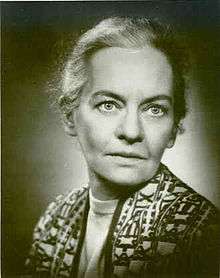Harriette Simpson Arnow
| Harriette Simpson Arnow | |
|---|---|
 | |
| Born |
Harriette Louisa Simpson July 7, 1908 Wayne County, Kentucky |
| Died |
March 22, 1986 (aged 77) Washtenaw County, Michigan |
| Pen name | H. L. Simpson |
| Occupation | writer, teacher |
Harriette Arnow (July 7, 1908 – March 22, 1986) was an American novelist, who lived in Kentucky and Michigan. Arnow has been called an expert on the people of the Southern Appalachian Mountains, but she herself loved cities and spent crucial periods of her life in Cincinnati and Detroit.
Early life and education
Arnow was born as Harriette Louisa Simpson in Monticello, Wayne County, Kentucky, and grew up in neighboring Pulaski County. She was one of six siblings in a family that traced its heritage to the Revolutionary War; both parents were teachers and she was raised to be a teacher.[1]
She attended Berea College for two years before transferring to the University of Louisville, after which she worked for two years as a teacher in rural Pulaski County, then one of the more remote areas of Appalachia, before moving to Cincinnati. In 1935 she published her first works in Esquire, two short stories — "A Mess of Pork" and "Marigolds and Mules" under the pen name H. L. Simpson, sending a photo of her brother-in-law to disguise her gender.
Career as writer
In 1936 she published her first novel, Mountain Path, basing it on her experiences as a teacher. Under the instructions of her publisher, Arnow added sensational "Appalachian" stereotypical elements (moonshining, feuds) to her original work, a much more sedate series of sketches.
From 1934–1939 she lived in Cincinnati and worked for the Federal Writer's Project of the WPA where she met her future husband, Harold B. Arnow,[2] the son of Jewish immigrants, in 1939. They lived briefly in Pulaski County, Harriette again working as a teacher, before settling in a public housing complex in Detroit, Michigan in 1944. Her 1949 novel, Hunter's Horn,[1] was a best seller and received considerable critical acclaim, finishing close to William Faulkner's A Fable in that year's voting for the Pulitzer Prize.
In 1950 they moved to Ann Arbor, Michigan. She published her most famous work The Dollmaker in 1954. This novel about a poor Kentucky family forced by economic necessity to move to Detroit reflected her own life, but also reflects the experiences of many Appalachians who migrated from their homes for the promise of better lives in the industrialized North. Told through the eyes of Gertie Nevels, a woman torn from the woods and farmland to move with her children to join her husband living in World War II factory workers' housing in Detroit, it can be seen as a work of feminist fiction. Arnow herself disputed this characterization however, preferring to see it as an individual woman's struggle to survive in a harsh and changing world [3] Of her writing she said, "I am afflicted with too many words ... Like the characters in my books, I talk too much and tell things I shouldn't tell."[4]
Later works included the historical studies Seedtime on the Cumberland and Flowering of the Cumberland. Her last books were the novels The Weedkiller's Daughter, 1970, The Kentucky Trace, 1974, and the memoir Old Burnside, 1977.
She died in 1986, aged 77, at her farm in Washtenaw County, Michigan.[4] Michigan State University Press brought out her previously unpublished second novel, Between the Flowers, in 1999, and The Collected Short Stories of Harriette Simpson Arnow in 2005.
References
- 1 2 "Oral History Interview with Harriette Arnow, April, 1976. Interview G-0006. Southern Oral History Program Collection (#4007)". Documenting the American South. University of North Carolina. Retrieved June 21, 2012.
- ↑ Chung, Haeja K., ed. (1995). Harriette Simpson Arnow : critical essays on her work. East Lansing: Michigan State University Press. ISBN 9780870133817.
- ↑ "A southern woman's view on the disjoint between feminism and individualism " in Oral Histories of the American South.
- 1 2 "Harriette Arnow Dies at 78; Author of 'The Dollmaker'". The New York Times. March 25, 1986. Retrieved May 24, 2010.
External links
- Works by or about Harriette Simpson Arnow in libraries (WorldCat catalog)
- Encyclopedia of Kentucky. New York, New York: Somerset Publishers. 1987. p. 110. ISBN 0-403-09981-1.
- Harriet Arnow (1908–1996) from the D. Hiden Ramsey Library Special Collections - Southern Appalachian Writers Collection at the University of North Carolina at Asheville.
- Arnow farm, Keno, Ky., history and photos
- Guide to Harriette Simpson Arnow papers, 1907-2004 housed at the University of Kentucky Libraries Special Collections Research Center